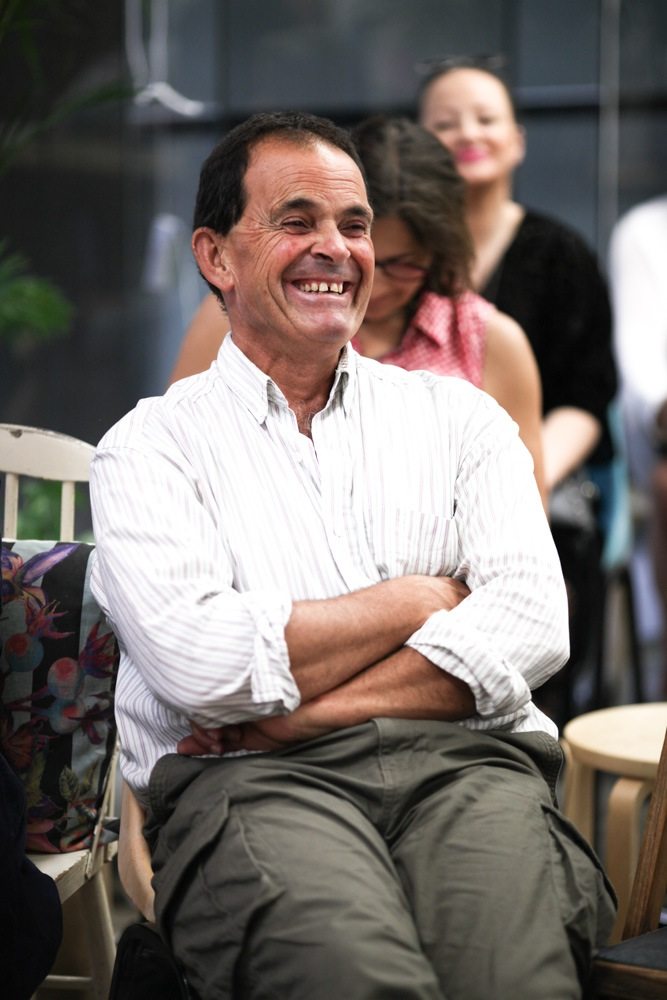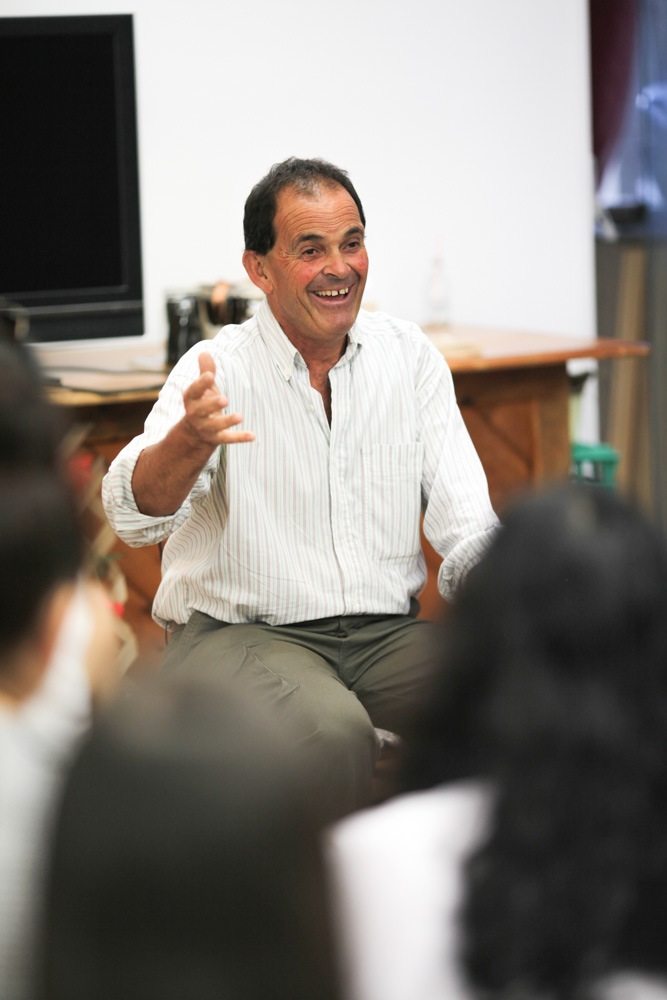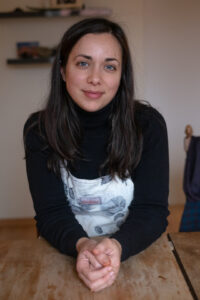 Basil Natoli – image by David Shen
Basil Natoli – image by David Shen
1. Basil, you are a teacher, gardener and activist. Could you tell us about your journey and work in these respective areas?
Of greatest influence I am sure was experience and exposure as a child to my grandfather’s garden at Black Rock, the regular family gatherings there and celebrations incorporating fruits and veggies from the garden and of course the seafood that he/we would bring home from the beach on a regular basis. As years passed I moved to the inner city and became a supporter of refugees and new arrivals desperately keen to develop a food growing garden on the Collingwood highrise estate. That was exciting..a little like opening a can of worms…the passion and excitement in the eyes of these elderly gardeners was heartwarming…I could see in these gardeners the eyes of my own grandfather and his connection to the earth.
2. You were a key facilitator in creating community gardens in and around Melbourne, including the first Stephanie Alexander Kitchen Garden Foundation (SAKGF) program at the Collingwood Community College. How did this come about?
Through my work in developing community gardens on the highrise estates and my involvement in the development of a community based organisation known as Cultivating Community I was able to trial a food growing project for children and families in three communities with high levels of social/cultural/economic disadvantage. In this project Peta Christensen the worker on the ground with these families provided the kids and households with the joy and experience of planting a veggie patch in the spring, nurturing their gardens through the summer and then celebrating the harvest in the autumn months. In the course of this project The Collingwood estate gardens were open to the public as part of an annual Harvest Celebration and great interest was generated around the notion of kids having access to gardens and growing their own food. I remember taking a phone call at home one morning and a woman introduced herself to me as Stephanie Alexander and spoke a little of her vision. We chatted then and shortly after with Peta Christensen over a cuppa at Stephanie’s cafe in Richmond…and that was the beginning of an exciting ongoing adventure. We introduced Stephanie to Frances Laurino – the principal at Collingwood College, and the kitchen garden program at Collingwood College commenced very soon after.
3. From start to finish, what was the process involved in implementing the first SAKGF program and what was the reaction of the students?
Principal Frances Laurino, Stephanie Alexander, Peta Christensen and I met a number of times teasing out how such a program could look and develop. From our very first meeting the project developed an energy of its own…however we were in the depths of winter and it really wasn’t the best time to try and plant veggies in the ground of a garden site that experienced major drainage issues. We faced lots of challenges, however the energy of the school community, Cultivating Community and of course Stephanie’s determination and commitment ensured that the project would get over all the inevitable hiccups that would crop up along the way. Of course the kids loved getting their hands dirty, getting out of the classroom and pushing wheel barrows and having fun and mischief along the way. From our very first meeting…the project commenced at Collingwood College within 10-11 weeks. An extraordinary example of what can happen when players are all on the same page!
 The Basil seedlings Basil gifted to each of our guests at our DC Gathering, all grown by him – image by Jen Curcio
The Basil seedlings Basil gifted to each of our guests at our DC Gathering, all grown by him – image by Jen Curcio
4. In your opinion what are the most important parts of having a garden and learning about/connecting with the earth?
Passion, respect for nature and the seasons and a preparedness to get your hands dirty…and celebrating successes along the way. Discovering soul mates who can share the vision is a tremendous support especially in those early days when starting a garden can involve lots of hard work and disappointment and things just don’t always go to plan. I was uplifted through my experiences in developing community gardens and similar projects by the passion and goodwill of like minded gardeners and volunteers, and of course by the friends that I made through Cultivating Community.
5. Which are your favourite public gardens in and around Melbourne?
We are blessed here in Melbourne…so many beautiful gardens to enjoy. Maranoa Gardens in Balwyn is a very special garden featuring plants and shrubs from all parts of Australia. The walk around the Abbotsford Convent and the Collingwood Children’s Farm is very special to me. I feel so priviliged to have this magical pocket of the Yarra and surrounding parklands on my own doorstep. The bushland of the Yarra Bend area…such an escape for Melbournians and visitors from afar…and of course the Botanic Gardens here in South Yarra and in Cranbourne…the list goes on. Can’t forget those very powerful little pocket handkerchief gardens that the City of Yarra has been creating in the back streets of Collingwood…such a gift to their respective communities.
6. What do you grow in your own garden?
My home garden here in Abbotsford provides me with a sense of calm and tranquility…the northern garden provides a beautiful leafy vista…a blend of cut leaf birches weeping so gracefully, magnolia grandiflora little gem and their magnificent blooms, underplanting of clivea and day lilies, cumquats and limes and a selection of strong plants that give a tropical feel…yuccas, bananas and strelitzia nicola. I love my side garden. The front garden faces west and gets battered by the extremes of summer. It has to survive on our unpredictable rainfall. I have a colossal gardenia stellata which must be over 100 years old and…the perfumed flowers are magical. Shortlived but ever so fragrant. As for fruit and veggies…these are all happening in the 3 school gardens where I work.
7. Do you have any tips, resources or advice for readers interested in growing their own produce or kitchen gardens?
Discover some like minded gardeners in your area…gardeners love to share their stories, garden tips and the fruits of their labour. If in doubt there is a wealth of information available on the web.
 Basil addressing the audience at our Summer Gathering last December – image by David Shen
Basil addressing the audience at our Summer Gathering last December – image by David Shen
8. Where are your favourite places to shop for fresh produce in and around Melbourne?
The markets of course…Preston market and Gleadell Street in Richmond. Victoria market and the fruit and veggie suppliers in Victoria Street, Richmond. My heart warms when I see elderly Vietnamese gardeners sitting on a stool or milk crate in the vicinity of Victoria Street selling fresh bunches of Asian greens and herbs grown and harvested from their nearby gardens.
9. The state of refugees in Australia has been a sore and troubled topic for many years. Given your work with newly arrived refugees via community gardens (often at/around community flats), what in your opinion are the best ways to welcome and help refugees?
I have absolutely no doubt that providing these new arrivals with the opportunity to get their hands into the earth and to grow something familiar that they can enjoy for culinary or medicinal purposes or just for the sheer pleasure and joy of being able to grow something beautiful, fresh or tasty can be so uplifting for the soul especially when spirits have been crushed not only by war and displacement but by the ravages of politics and vote scoring associated with resettlement. We should be providing gardens and gardeners with therapeutic and recreational benefits and opportunities to assist refugees in the resettlement process and to especially combat the social/emotional and mental health issues that are inevitably experienced by individuals who feel lost and without hope.
10. You spoke at our first gathering event in December last year and shared a recipe of your Mother’s. Would you feel comfortable sharing that with our readers?
Of course…my Mum’s minestrone is the best !!
Grandma Ven’s Minestrone
My dear Mum died the year before last aged 89. Wonderful Mum & brilliant cook. She taught us the importance of gathering family around the kitchen table. Whilst her parents originated from Isole Eolie in Southern Italy, I think her parents may have had a secret love affair with the North & christened her Venezia Maria.
Grandma Ven’s Minestrone -no passata, no drizzling with gourmet olive oil, SIMPLE but to die for!! Even more delicious after 2-3 days. This dish is always good for a crowd. Stretch it out with good crusty Italian bread & a glass of red. Fantastic for a cold winter’s day. You can work out your own quantities.
Make a big pot stock (chicken or lamb shanks) with assorted seasonings.
Soak/prepare&cook half a mixing bowl full of lima beans or borlotti or both. Set aside.
Cut macaroni x 2-3 cups. Boil & set aside.
Coarsely chopped cabbage. Be generous…big bowl full. Set aside.
Carrots/parsnips/celery/parsley 2-3 of each diced. Add diced bacon pieces&braise together in a little oil.
Gradually add stock as more ingredients are added…braising&stirring regularly.
Add lima beans…continue to braise.
Add cooked cut macaroni&chopped cabbage towards the end. Don’t overcook to a pulp!!
Additional cracked pepper&salt to taste…simmer gently as flavours combine.
Serve when aroma is too hard to resist. Sprinkle with parmesan or similar.
Add some crusty bread & a glass of red. Buon appetito!
11. What projects are you currently working on, any new ones on the horizon?
More gardens in schools and gardening for kids of ALL abilities…I’ll be doing this until I can’t.
You’ll also like:
Foodie Profile #20: Plants on Pink
Growing Honest Food by Gabriella Gomersall – Hubbard
Review: Down to Earth by Rhonda Hetzel









